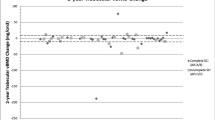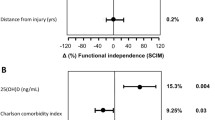Abstract
Spinal cord injury (SCI) leads to severe bone loss, but the associated mechanisms are poorly described in incomplete SCI individuals. The purpose of the study is to compare alterations in bone mineral density (BMD) and serum biomarkers of bone turnover in recent motor-incomplete to -complete SCI men, as well as to describe their physical activity and spasticity. We studied 31 men with acute SCI. Whole-body DXA scans, serum biomarkers and self-reported activity and spasticity were examined 1 and/or 3 and 12 months after the injury. We observed a decrease in proximal femur BMD (p < 0.02) in both the groups. Serum phosphate and carboxy-terminal-collagen crosslinks were significantly lower in motor-incomplete versus complete SCI men, whereas albumin-corrected Ca2+ (p = 0.02) were lower only 3 months after injury. When data from all 31 SCI participants were pooled, we observed increased serum matrix metalloproteinase-2 (MMP-2) and tissue inhibitors of MMP-2 (TIMP-2) (p < 0.02) whereas TIMP-1 decreased (p = 0.03). BMD correlated positively with self-reported activity (r = 0.59, p = 0.04) and negatively with spasticity (r = 0.74, p = 0.02) 12 months after injury. As a summary, men with motor-incomplete SCI developed significant proximal femur bone loss 12 months after injury and exhibited increased bone resorption throughout the first year after the injury. Compared with complete SCI men, incomplete SCI men show attenuated bone resorption. Our pooled data show increased turnover of extracellular matrix after injury and that increased exercise before and after injury correlated with reduced bone loss.



Similar content being viewed by others
References
Gifre L, Vidal J, Carrasco J, Portell E, Puig J, Monegal A, Guanabens N, Peris P (2014) Incidence of skeletal fractures after traumatic spinal cord injury: a 10-year follow-up study. Clin Rehabil 28:361–369
Roberts D, Lee W, Cuneo RC, Wittmann J, Ward G, Flatman R, McWhinney B, Hickman PE (1998) Longitudinal study of bone turnover after acute spinal cord injury. J Clin Endocrinol Metab 83:415–422
Charmetant C, Phaner V, Condemine A, Calmels P (2010) Diagnosis and treatment of osteoporosis in spinal cord injury patients: a literature review. Ann Phys Rehabil Med 53:655–668
Jiang SD, Jiang LS, Dai LY (2006) Mechanisms of osteoporosis in spinal cord injury. Clin Endocrinol (Oxf) 65:555–565
Jiang SD, Dai LY, Jiang LS (2006) Osteoporosis after spinal cord injury. Osteoporos Int 17:180–192
Battaglino RA, Lazzari AA, Garshick E, Morse LR (2012) Spinal cord injury-induced osteoporosis: pathogenesis and emerging therapies. Curr Osteoporos Rep 10:278–285
Garland DE, Stewart CA, Adkins RH, Hu SS, Rosen C, Liotta FJ, Weinstein DA (1992) Osteoporosis after spinal cord injury. J Orthop Res 10:371–378
Lazo MG, Shirazi P, Sam M, Giobbie-Hurder A, Blacconiere MJ, Muppidi M (2001) Osteoporosis and risk of fracture in men with spinal cord injury. Spinal Cord 39:208–214
Garland DE, Adkins RH, Scott M, Singh H, Massih M, Stewart C (2004) Bone loss at the os calcis compared with bone loss at the knee in individuals with spinal cord injury. J Spinal Cord Med 27:207–211
Garland DE, Adkins RH, Stewart CA (2008) Five-year longitudinal bone evaluations in individuals with chronic complete spinal cord injury. J Spinal Cord Med 31:543–550
Maimoun L, Fattal C, Micallef JP, Peruchon E, Rabischong P (2006) Bone loss in spinal cord-injured patients: from physiopathology to therapy. Spinal Cord 44:203–210
Singh R, Rohilla RK, Saini G, Kaur K (2014) Longitudinal study of body composition in spinal cord injury patients. Ind J Orthop 48:168–177
Giangregorio LM, Webber CE, Phillips SM, Hicks AL, Craven BC, Bugaresti JM, McCartney N (2006) Can body weight supported treadmill training increase bone mass and reverse muscle atrophy in individuals with chronic incomplete spinal cord injury? Appl Physiol Nutr Metab 31:283–291
National Spinal Cord Injury Statistical C (2011) National Spinal Cord Injury Statistical Center, University of Alabama at Birmingham, 2010 Annual Statistical Report, March, 2011.
Maynard FM Jr, Bracken MB, Creasey G, Ditunno JF Jr, Donovan WH, Ducker TB, Garber SL, Marino RJ, Stover SL, Tator CH, Waters RL, Wilberger JE, Young W (1997) International standards for neurological and functional classification of spinal cord injury. American spinal injury association. Spinal Cord. 35:266–274
Graff-Iversen S, Anderssen SA, Holme IM, Jenum AK, Raastad T (2008) Two short questionnaires on leisure-time physical activity compared with serum lipids, anthropometric measurements and aerobic power in a suburban population from Oslo, Norway. Eur J Epidemiol 23:167–174
Aires N, Selmer R, Thelle D (2003) The validity of self-reported leisure time physical activity, and its relationship to serum cholesterol, blood pressure and body mass index. A population based study of 332,182 men and women aged 40–42 years. Eur J Epidemiol 18:479–485
Marcus BH, Rakowski W, Rossi JS (1992) Assessing motivational readiness and decision making for exercise. Health Psychol 11:257–261
Nigg CR, Courneya KS (1998) Transtheoretical model: examining adolescent exercise behavior. J Adolesc Health 22:214–224
Prapavessis H, Maddison R, Brading F (2004) Understanding exercise behavior among New Zealand adolescents: a test of the transtheoretical. J Adolesc Health 35:346.e317–346.e327
Lee RE, Nigg CR, DiClemente CC, Courneya KS (2001) Validating motivational readiness for exercise behavior with adolescents. Res Q Exerc Sport 72:401–410
Bulley C (2008) Stages of exercise behavior change: a pilot study of behavioral measures. J Int Health Promot 46:6
Priebe MM, Sherwood AM, Thornby JI, Kharas NF, Markowski J (1996) Clinical assessment of spasticity in spinal cord injury: a multidimensional problem. Arch Phys Med Rehabil 77:713–716
Hsieh JT, Wolfe DL, Miller WC, Curt A (2008) Spasticity outcome measures in spinal cord injury: psychometric properties and clinical utility. Spinal Cord 46:86–95
Mazess RB, Barden HS, Bisek JP, Hanson J (1990) Dual-energy x-ray absorptiometry for total-body and regional bone-mineral and soft-tissue composition. Am J Clin Nutr 51:1106–1112
Miller PD (2006) Guidelines for the diagnosis of osteoporosis: T-scores vs fractures. Rev Endocr Metab Disord 7:75–89
Boesen AP, Dideriksen K, Couppe C, Magnusson SP, Schjerling P, Boesen M, Kjaer M, Langberg H (2013) Tendon and skeletal muscle matrix gene expression and functional responses to immobilisation and rehabilitation in young males: effect of growth hormone administration. J Physiol 591:6039–6052
Allal-Elasmi M, Zayani Y, Zidi W, Zaroui A, Feki M, Mourali S, Mechmeche R, Kaabachi N (2014) The measurement of circulating matrix metalloproteinase-8 and its tissue inhibitor and their association with inflammatory mediators in patients with acute coronary syndrome. Clin Lab 60:951–956
Wilmet E, Ismail AA, Heilporn A, Welraeds D, Bergmann P (1995) Longitudinal study of the bone mineral content and of soft tissue composition after spinal cord section. Paraplegia 33:674–677
Maynard FM, Imai K (1977) Immobilization hypercalcemia in spinal cord injury. Arch Phys Med Rehabil 58:16–24
Niemann I, Hannemann A, Nauck M, Spielhagen C, Volzke H, Wallaschofski H, Friedrich N (2013) The association between insulin-like growth factor I and bone turnover markers in the general adult population. Bone 56:184–190
Paker N, Bugdayci D, Ersoy S, Uysal E, Elbirlik S (2007) Bone loss and bone turnover in acute and chronic spinal cord injured patients. Neurosciences (Riyadh) 12:232–235
Astorino TA, Harness ET, Witzke KA (2013) Effect of chronic activity-based therapy on bone mineral density and bone turnover in persons with spinal cord injury. Eur J Appl Physiol 113:3027–3037
Maimoun L, Couret I, Mariano-Goulart D, Dupuy AM, Micallef JP, Peruchon E, Ohanna F, Cristol JP, Rossi M, Leroux JL (2005) Changes in osteoprotegerin/RANKL system, bone mineral density, and bone biochemicals markers in patients with recent spinal cord injury. Calcif Tissue Int 76:404–411
Reiter AL, Volk A, Vollmar J, Fromm B, Gerner HJ (2007) Changes of basic bone turnover parameters in short-term and long-term patients with spinal cord injury. Eur Spine J 16:771–776
Belanger M, Stein RB, Wheeler GD, Gordon T, Leduc B (2000) Electrical stimulation: can it increase muscle strength and reverse osteopenia in spinal cord injured individuals? Arch Phys Med Rehabil 81:1090–1098
Alekna V, Tamulaitiene M, Sinevicius T, Juocevicius A (2008) Effect of weight-bearing activities on bone mineral density in spinal cord injured patients during the period of the first two years. Spinal Cord 46:727–732
Dudley-Javoroski S, Saha PK, Liang G, Li C, Gao Z, Shields RK (2012) High dose compressive loads attenuate bone mineral loss in humans with spinal cord injury. Osteoporos Int 23:2335–2346
Frotzler A, Coupaud S, Perret C, Kakebeeke TH, Hunt KJ, DonaldsonNde N, Eser P (2008) High-volume FES-cycling partially reverses bone loss in people with chronic spinal cord injury. Bone 43:169–176
Eser P, de Bruin ED, Telley I, Lechner HE, Knecht H, Stussi E (2003) Effect of electrical stimulation-induced cycling on bone mineral density in spinal cord-injured patients. Eur J Clin Invest 33:412–419
Ben M, Harvey L, Denis S, Glinsky J, Goehl G, Chee S, Herbert RD (2005) Does 12 weeks of regular standing prevent loss of ankle mobility and bone mineral density in people with recent spinal cord injuries? Aust J Physiother 51:251–256
Wannapakhe J, Arrayawichanon P, Saengsuwan J, Amatachaya S (2013) Medical complications and falls in patients with spinal cord injury during the immediate phase after completing a rehabilitation program. J Spinal Cord Med [Epub ahead of print]
Lidal IB, Jensen AE, Larsen TW, Stanghelle JK (2013) Fatigue in persons who have lived with spinal cord injury for >20 years. Spinal Cord 51:103–108
Acknowledgments
We wish to thank the staff at Department of Endocrinology, Morbid Obesity and Preventive Medicine, Oslo University Hospital Oslo, Norway for all the help with the DXA-measurements and analysis, and Anne Lannem, the Department of Science, Sunnaas Rehabilitation Hospital, Nesoddtangen, Norway for the help with the physical activity questionnaires. A special thanks to Ingeborg Lidal, for allowing us to quote her unpublished data; Jan Falck and Kåre Birkeland, the Department of Endocrinology, Morbid Obesity and Preventive Medicine, Oslo University Hospital Oslo, Norway for expert advice; and Hilde Einerkjær, Mariann Madsen Voll and Sunnaas Rehabilitation Hospital, Nesoddtangen, for performing the blood sampling.
Conflicts of Interest
No conflicts of interest, financial or otherwise, are declared by the authors Emil Kostovski, Nils Hjeltnes, Erik Fink Eriksen, Svein Olav Kolset, and Per Ole Iversen.
Human and Animal Rights and Informed Consent
Each study participant gave verbal and written informed consent prior to the study.
Author information
Authors and Affiliations
Corresponding author
Appendix
Appendix
See Table 4.
Rights and permissions
About this article
Cite this article
Kostovski, E., Hjeltnes, N., Eriksen, E.F. et al. Differences in Bone Mineral Density, Markers of Bone Turnover and Extracellular Matrix and Daily Life Muscular Activity Among Patients with Recent Motor-Incomplete Versus Motor-Complete Spinal Cord Injury. Calcif Tissue Int 96, 145–154 (2015). https://doi.org/10.1007/s00223-014-9947-3
Received:
Accepted:
Published:
Issue Date:
DOI: https://doi.org/10.1007/s00223-014-9947-3




